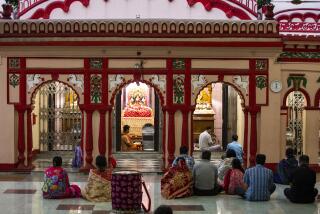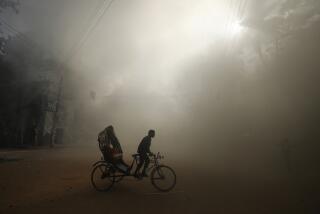Nature a Familiar Demon in Bangladesh
- Share via
GOHIRA, Bangladesh — At dusk on Fridays, the Muslim Sabbath, a group of bare-chested men gathers at the seashore to pray. The sea is their redeemer, providing food and jobs.
It is also their demon.
Five years ago, they survived a cyclone that swept in from the Bay of Bengal, submerged much of Bangladesh’s coast and offshore islands and killed 139,000 people.
“We come to pray so that the demon from the sea does not rise again,” said Syed Ali, a crane operator in the port of Chittagong.
But this country has many demons.
In May, a tornado roared across three northern provinces, destroying 80 villages and killing 621 people in 30 minutes of devastation.
In 1988, swollen rivers inundated two-thirds of the country, forcing 30 million people from their homes and killing 2,000.
In 1970, an estimated 500,000 people died when a 20-foot tidal wave washed over Chittagong and hundreds of coastal villages.
Bangladesh, a nation the size of Wisconsin into which 120 million people are packed, is battered by nature with brutal regularity. Cyclones, tornadoes, floods, heat waves and cold spells alternate throughout the year.
Over the last 36 years, the period for which government statistics are available, 706,000 people have died in natural disasters--an average of nearly 20,000 every year.
The 1991 cyclone was so devastating that the United States diverted 7,500 Marines and sailors returning to home port from the Gulf War for a rescue mission.
The Americans installed hand pumps that gave access to clean underground water, helping check an outbreak of cholera from ground water contaminated after the storm. They also repaired roads to bring in relief supplies and provided food and tents by helicopter. Grateful survivors called them the “Sea Angels.”
The U.S. government gave $350 million in emergency aid. But despite that, and an infusion of $2 billion a year from donors for development, Bangladesh’s defenses against nature remain thin.
“We cannot change geography,” said Harun al-Rahid, operations director of the government’s Cyclone Preparedness Program. “The only course left before us is to find ways to minimize losses.”
Bangladesh acts as a funnel for winds blowing off the conically shaped Bay of Bengal, a warm sea that is a breeding ground for cyclones.
Four major rivers with 230 tributaries spill out of the Himalayas and slice across the Bangladesh delta, settling 24 million tons of silt each year into river channels. That makes them more prone to flooding.
The pressure of a swiftly growing population has stripped the land of most of its trees, adding to the vulnerability of the soil. Forest now covers only 9% of the country, compared to 25% in 1960.
“We have 11 million people living in the low-lying coastal areas and in the offshore islands,” said Fazlul Wahab, chief of the Cyclone Preparedness Program. “They live under threat of death all the time.”
Repeated catastrophes conspire to keep Bangladesh poor, diverting attention from development projects for the 40% of the people who do not get enough to eat and the 70% who cannot read or write.
The floods of 1988, for example, put two-thirds of the country under water, killed 2,000 people, displaced 30 million more, destroyed 253,000 homes, ruined crops on 52 million acres and killed 115,000 cattle.
“One disaster eats up all the developmental work, and the statistics speak for themselves,” said economist Abdul Latif Mannan.
The loss from the 1991 cyclone was calculated at $1.7 billion, or 31% of Bangladesh’s annual budget.
Millions of people like Syed Ali, the crane operator, know they live on the edge, but can do nothing about it. His hut, built from mud and thatch, is barely 550 yards from the shore and will disappear with the first puff of cyclonic wind.
“I know we can be hit by another cyclone any day, but what options do we have?” he said. “I am surely scared, but can you tell me what I can do?”
Although nothing can save his flimsy home from a storm, officials are working to secure his life.
At the Cyclone Preparedness Program, red, yellow and pink pins on a map mark 130 radio stations in high-risk areas to send cyclone warnings. In addition, 32,000 volunteers have been recruited to spread warnings by word of mouth.
About 1,000 brick cyclone shelters have been built along the coast since 1991, when there were only 20. The shelters, which serve as schools most of the time, are designed to hold 1,000 people each during a storm, but officials say they can accommodate 2,000 to 2,500.
Bangladesh hopes to build at least 5,000 more coastal shelters in the next three to four years. But the government concedes it cannot pay for that on its own and is seeking financial help from wealthy nations.
“If I had a magic wand, I would have dotted our coasts with cyclone shelters. But, alas, I neither have the magic stick nor the money,” said Wahab, the Cyclone Preparedness Program chief.
More to Read
Sign up for Essential California
The most important California stories and recommendations in your inbox every morning.
You may occasionally receive promotional content from the Los Angeles Times.










